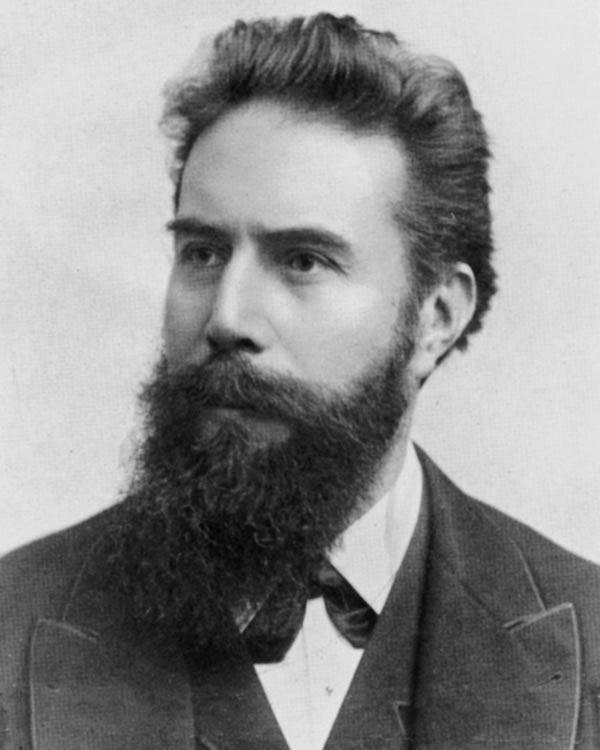Wilhelm Conrad Röntgen (1845–1923)
Physicist

Wilhelm Conrad Röntgen came into the world in the little Prussian town of Lennep on 25 March 1845 as the son of a Rheinland cloth merchant. Presumably for business reasons, the family moved to the Dutch town of Apeldoorn. After attending a private school, Röntgen continued his education at the Technical School in Utrecht from August 1862. Two years later, however, he was rejected for the "Abitur" (equivalent of A-Levels) on disciplinary grounds, despite his excellent marks.
Application at the Federal Polytechnic Institute
This rejection and a failed entrance exam meant that he could not complete a fully recognised degree in the Netherlands. This fact prompted him – after one-year stint as a guest lecturer at the University of Utrecht – to apply to the Federal Polytechnic Institute in Zurich.
Admission at the Federal Polytechnic Institute
The Polytechnic normally demanded a successful entrance exam as an admission requirement for a degree. Nevertheless Röntgen was accepted as a student at the Mechanical-Technical School (Department III) in the winter semester of 1865/66 without an exam on account of his "mature age" of twenty and "admirable record at the Technical School in Utrecht, especially in mathematics" (The ETH Library, ETH Zurich University Archives, EZ-REK 1/1/1837, Wilhelm Conrad Röntgen's student register, letter from Moritz Schröter to Gustav Zeuner dated 23 November 1865). Röntgen completed his first degree three years later on 6 August 1868 with a diploma in mechanical engineering.
Postgraduated course under August Kundt
He added another string to his bow with a postgraduate degree in physics under Professor August Kundt, who was only six years his senior. The encounter with Kundt would shape the rest of his research career. On 22 June 1868 Röntgen completed a doctorate at the neighbouring University of Zurich with his thesis "Studien über Gase" (Studies on Gases), which was supervised by Gustav Zeuner and examined the connection between thermodynamics and the properties of gases. In 1870 he followed his mentor, August Kundt, to the University of Wurzburg as an assistant, where he did not qualify as a professor, however, on account of his lack of an Abitur. Nonetheless, he eventually became a professor when both physicists moved to the University of Strasbourg on 13 March 1874.
Stay abroad
Two years later, following a brief spell as a professor of mathematics and physics at the Landwirtschaftliche Akademie in Hohenheim, Röntgen was also appointed as an associate professor and head of the 2nd Chair of Physics in Strasbourg at Kundt's recommendation. In 1879 he became a full professor at the University of Giessen. In 1888 he was appointed as full professor of Physics at the University of Wurzburg and as head of the Physical Institute.
Discovery the rays
It was at this university that, on 8 November 1895, he discovered as yet unknown rays when working with cathode ray tubes – widespread among physicists at the time – which he christened x-rays in his subsequent ground-breaking publication "Ueber eine neue Art von Strahlen" (About a New Kind of Rays) after the unknown in mathematics. Early photographs of hand bones proved the existence of the rays as the first "x-ray images" in history and already bode well for medical use. Five years later, Röntgen became a professor in Munich, where he remained until 1920. Through his discovery of the x-ray, the German word for which is actually named after him (Röntgenstrahlung), which hailed a new era of medical diagnostics and therapy and the structural detection of crystals and molecules, Röntgen became world-famous and received the first external page Nobel Prize for Physics on 10 December 1901.
Other scientific achievements
His other scientific achievements are less well-known outside the research world: for instance, he succeeded in confirming the birefringence of liquids in an electrical field that Kerr had expected (Kerr effect). In Giessen, Germany, he provided evidence that a magnetic effect is created in dielectric material moved between electrically charged capacitor plates, i.e. by the Röntgen current, a term coined by Hendrik Antoon Lorentz. Moreover, he managed to find evidence of the displacement current predicted by Maxwell's Theory.
Röntgen, who died in poverty (as a result of inflation) in Giessen on 10 February 1923, shied away from the public eye during his lifetime. For instance, he only ever held one single talk on his discovery of x-rays and declined the invitation to his Nobel Prize speech. Nor did he have his valuable discovery patented, which probably accelerated its utilisation in various fields.
Manuscript

Holdings
ETH Zurich University Archives holds Wilhelm Conrad Röntgen's student register, which also includes the correspondence concerning his acceptance process for the Polytechnic. Information on Röntgen's studies can also be found on the platform Schulratsprotokolle Online.
A biographical dossier also documents his life, work and reception in the form of newspaper articles and obituaries. The holding Hs 733 contains a script for a scheduled documentary on Wilhelm Conrad Röntgen from 1965/66.
All Nobel Prize laureates of ETH Zurich at a glance